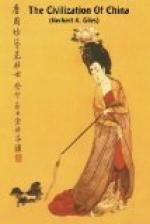The written characters, known to have been in use for the past three thousand years, were originally rude pictures, as of men, birds, horses, dogs, houses, the numerals (one, two, three, four), etc., etc., and it is still possible to trace in the modified modern forms of these characters more or less striking resemblances to the objects intended. The next step was to put two or more characters together, to express by their combination an abstract idea, as, for instance, a hand holding a rod = father; but of course this simple process did not carry the Chinese very far, and they soon managed to hit on a joint picture and phonetic system, which enabled them to multiply characters indefinitely, new compounds being formed for use as required. It is thus that new characters can still be produced, if necessary, to express novel objects or ideas. The usual plan, however, is to combine existing terms in such a way as to suggest what is wanted. For instance, in preference to inventing a separate character for the piece of ordnance known as a “mortar,” the Chinese, with an eye to its peculiar pose, gave it the appropriate name of a “frog gun.”
Again, just as the natives and the dialects of the various parts of China differ one from another, although fundamentally the same people and the same language, so do the manners and customs differ to such an extent that habits of life and ceremonial regulations which prevail in one part of the empire do not necessarily prevail in another. Yet once more it will be found that the differences which appear irreconcilable at first, do not affect what is essential, but apply rather to matters of detail. Many travellers and others have described as customs of the Chinese customs which, as presented, refer to a part of China only, and not to the whole. For instance, the ornamental ceremonies connected with marriage vary in different provinces; but there is a certain ceremony, equivalent in one sense to signing the register, which is almost essential to every marriage contract. Bride and bridegroom must kneel down and call God to witness; they also pledge each other in wine from two cups joined together by a red string. Red is the colour for joy, as white is the colour for mourning. Chinese note-paper is always ruled with red lines or stamped with a red picture. One Chinese official who gave a dinner-party in foreign style, even went so far as to paste a piece of red paper on to each dinner-napkin, in order to counteract the unpropitious influence of white.




